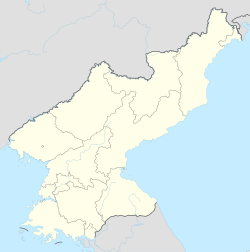Hamhung
|
Hamhung 함흥시 |
|
|---|---|
| Municipal City | |
| Korean transcription(s) | |
| • Chosŏn'gŭl | |
| • Hancha | |
| • McCune-Reischauer | Hamhŭng-si |
| • Revised Romanization | Hamheung-si |

A view of Hamhung
|
|
| Coordinates: 39°55′N 127°32′E / 39.917°N 127.533°E | |
| Country |
|
| Region | Kwannam |
| Area | |
| • Total | 330 km2 (130 sq mi) |
| Population (2008) | |
| • Total | 768,551 |
| • Dialect | Hamgyŏng |
Hamhŭng (Hamhŭng-si; Korean pronunciation: [ham.ɦɯŋ]) is North Korea's second largest city, and the capital of South Hamgyŏng Province. In late 2005, nearby Hŭngnam was made a ward (kuyŏk) within Hamhŭng-si. It has a population of 768,551 as of 2008[update].
Hamhŭng is divided into 7 kuyŏk (wards):
Hamhŭng is on the left branch of the Sŏngch'ŏn River, on the eastern part of the Hamhŭng plain (함흥평야), in South Hamgyŏng Province, northeast North Korea. The Tonghŭngsan is 319 m high.
Yi Sung-ke, founder of the Yi Dynasty, retired to the city after a successful palace coup by his son Yi Bang-won in 1400. Though his son sent envoys to reconcile, his father had them killed. A modern Korean expression, 'King's envoy to Hamhŭng' (Hamheungchasa), refers to a person who goes on a journey and is never heard from again. It was known as Kankō during Japanese rule of Korea between 1910 and 1945. It was liberated by the Red Army on 22 August 1945.
The city was heavily damaged (80–90%) during the Korean War and was occupied by ROK troops between 17 October 1950 and 17 December 1950. From 1955 to 1962, Hamhŭng was the object of a large-scale program of reconstruction and development by East Germany including the build-up of construction-related industries and intense training measures for Korean construction workers, engineers, city planners and architects. The project ended two years earlier than scheduled and with a low profile because of the Sino-Soviet conflict and the opposing positions that North Korea and East Germany took on that issue.
...
Wikipedia

